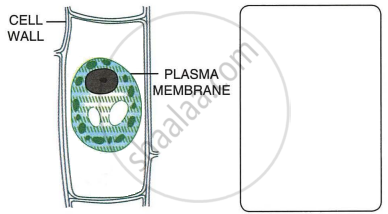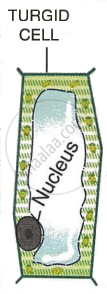Advertisements
Advertisements
प्रश्न
A leaf cell of a water plant was placed in a liquid other than pond water. After sometime, it assumed a shape as shown below:

- Give the term for the state of the cell it has acquired.
- Name the structure which acts as a selectively permeable membrane.
- Comment on the nature (tonicity) of the liquid surrounding the cell.
- Name any one feature of this plant cell which is not present in an animal cell.
- Redraw in the space provided, the diagram of the cell if it is soon placed in ordinary water for some time.
उत्तर
- Flaccid Cell (Plasmolysis)
- Plasma membrane
- Hypertonic solution
- Presence of cell wall

APPEARS IN
संबंधित प्रश्न
The diagram below represents a process in plants. The setup was placed in bright sunlight. Answer the following questions:

a) Name the physiological process depicted in the diagram.
Why was oil added to the water?
b) When placed in bright sunlight for four hours, what do you observe with regard to the initial and final weight of the plant? Give a suitable reason for your answer
c) What happens to the level of water when this setup is placed in:
- Humid conditions?
- Windy conditions?
d) Mention any three adaptations found in plants to overcome the process mentioned in (i).
e) Explain the term ‘Guttation’.
Differentiate between the following:
Turgidity and Flaccidity
Give reason for the following:
A plant cell, when kept in a hypertonic salt solution for about 30 minutes, turns flaccid.
Distinguish between the following:
Flaccid condition and turgid condition
Differentiate between the following:
Plasmolysis and Deplasmolysis.
Name the following:
The condition in which the contents of a cell exert pressure against the cell wall making it distended.
Mention, if the following statement is True or False. If false rewrite the wrong statement in its correct form:
Flaccidity is the reverse of turgidity.
Deplasmolysis occurs when a plasmolysed cell is placed in ______.
The hydrostatic pressure of the cell sap on the cell wall is called ______.
